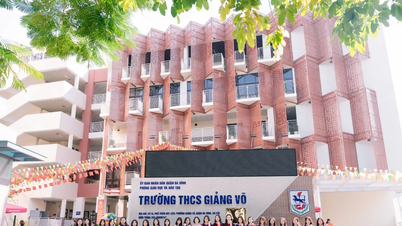The gap in benchmark scores from 10 to 25.5 is not simply a matter of input but reflects the large difference ineducational quality between regions and schools from inner city to suburbs.
More than 15 points of difference - increasingly clear stratification
According to statistics from the Hanoi Department of Education and Training, the benchmark for admission to public grade 10 in 2025 ranges from 10.00 to 25.5 points. Kim Lien High School leads with the highest benchmark score of 25.5 points, equivalent to an average of 8.5 points/subject, followed by Nguyen Gia Thieu, Le Quy Don (Ha Dong), Yen Hoa, Phan Dinh Phung, Viet Duc... all with benchmark scores above 25 points.
On the contrary, many public schools in the suburbs such as Dai Cuong, Minh Quang, Luu Hoang High Schools... only take from 10 to 15 points, which means an average of 3 to 5 points per subject.

The difference between the school with the highest standard score and the school with the lowest is 15.5 points.
Notably, more than 90 schools have had their average subject scores decrease compared to last year. The gap between the school with the highest and lowest benchmark scores is 15.5 points. Many schools have had their benchmark scores drop sharply compared to 2023 and 2024.
For example, Tho Xuan High School (Dan Phuong) dropped by nearly 8.5 points. Last year, the school had a benchmark score of 30.75, meaning an average of 6.15 points per subject would be accepted. This year, the school has a benchmark score of 10, meaning an average of 3.33 points per subject would be accepted.
This year, there are 26 schools with benchmark scores below 5 points/subject, nearly double that of 2024 (12 schools). Meanwhile, only 9 schools achieved the threshold above 8 points/subject - accounting for less than 10% of 115 public schools. These numbers reflect a reality: the public high school system in Hanoi is clearly stratified.
In fact, there are students who score 24 points but still cannot get into their dream school, while in other schools, only 10 points are needed to be admitted. The fact that admission takes place in the same exam, with the same questions, but the difference in the entrance score is up to ten points is a concern for many teachers, parents and students.
"I got 22 points, but still couldn't get into a top school in the inner city district. Meanwhile, my friend, who is in the same class but in another district, only needed 15 points to get into a public school. I feel it's a bit unfair because we all studied the same subject but our opportunities are so different. If I had known in advance, I would have chosen a less competitive school, even though it wasn't my favorite," Duc Anh, a 9th grader, shared after studying the admission score. score.
For a long time, not only students and parents but also the whole society have acknowledged that, in order to “squeeze in” to get into top schools, the pressure on students is even higher than the university entrance exam. Although there are 115 public high schools in Hanoi, the reality shows that only about 15-20 schools are the “dream destination” of the majority of students and parents, leading to overload at the top schools and a shortage of students at the lower groups.
On the other hand, many schools in the suburbs do not meet their enrollment quotas, and even “save” the third choice but still lack students. This creates a paradox: High-quality schools are overloaded, students have to “fight” under great pressure, while low-quality schools have students with enough scores but… do not want to enter, or even if they enter, they worry about the quality of teaching.
Behind the score is the quality gap
The big difference in benchmark scores is not only a matter of candidates' abilities, but also reflects the difference in education quality between regions, from facilities, teaching staff, to learning conditions.
"I don't expect every school to be like Kim Lien or Yen Hoa, but at least the gap in entrance exams shouldn't be too big. My child scored 24 points but still failed the school of his dreams, while his classmate scored only 16 points and was admitted to a school in the suburbs. He feels disadvantageously, even though he studies the same curriculum and has the same exam questions. It feels like we're in the same race but starting at different starting lines," said parent Thu Phuong.
This inequality also lies in the psychology of admission: inner-city parents always orient their children to study at “top” schools, while in the suburbs, the mentality of choosing schools “within their ability”, as long as there is a place in grade 10, is common. This makes the competition rate at prestigious schools increase, giving rise to fierce competition.
"Students take the same test, but which school to enter is a fierce competition. Everyone wants to go to a school with good teachers, a good learning environment, and many good students - that unintentionally creates a cycle: good schools get better and better, weak schools find it harder to break through," said Ms. Thu Ha, a teacher at a secondary school in Hanoi.

It is necessary to narrow the quality gap between schools so that all students, wherever they are, have equal and quality learning opportunities.
Many education experts believe that the difference in benchmark scores between schools shows that the public school system is clearly stratified. The concentration of students in a few "hot" schools creates great pressure, while schools in other areas face difficulties in recruiting students and ensuring quality. Without strong policies to invest in education in disadvantaged areas, the public education system will become increasingly stratified.
It can be seen that the gap between top and bottom schools is the result of an imbalance in investment and educational planning. If not solved at the root, each admission season will remain an unequal battle and create injustice in access to education. It is time for more drastic and long-term policies so that all students, wherever they are, have equal and quality learning opportunities.
Source: https://vtcnews.vn/tuyen-sinh-lop-10-o-ha-noi-truong-top-tren-vuot-dinh-truong-vung-ven-cham-day-ar952928.html






![[Photo] Prime Minister Pham Minh Chinh receives leaders of several leading Brazilian corporations](https://vphoto.vietnam.vn/thumb/1200x675/vietnam/resource/IMAGE/2025/7/6/3622160b379746e6bca82f804ea35e47)














































































![[OCOP REVIEW] Bay Quyen sticky rice cake: A hometown specialty that has reached new heights thanks to its brand reputation](https://vphoto.vietnam.vn/thumb/402x226/vietnam/resource/IMAGE/2025/7/3/1a7e35c028bf46199ee1ec6b3ba0069e)










Comment (0)